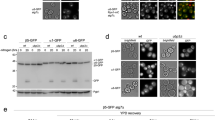Abstract
Native polyacrylamide gel electrophoresis (PAGE) is an invaluable technique in biochemistry to characterize native protein complexes with high molecular mass. Thus, native PAGE is suited to resolve proteasomes, giant proteases responsible for the degradation of polyubiquitylated proteins. Proteasomes contain multiple subunits and exist in different configurations. All configurations have a common 20S core particle (CP). The CP encloses the proteolytic chamber and is composed of four stacked rings with C2 symmetry. The entrance to the CP is gated by central pores within the outer rings, which also provide the binding sites for the 19S regulatory complex (RP). Adjacent regulatory proteins, such as Blm10/PA200, are bound to specific proteasome species of low abundance and contribute to the heterogeneity of proteasome complexes. To get insight into the complexity of proteasome configurations in yeast, we developed a native PAGE system by which GFP-labelled variants of proteasomal subunits are visualized by phosphofluoroimaging. Following native PAGE, proteasome species can be subjected to in-gel activity assays, subsequent SDS-PAGE, and Western blotting.
Access this chapter
Tax calculation will be finalised at checkout
Purchases are for personal use only
Similar content being viewed by others
References
Hough, R., Pratt, G., and Rechsteiner, M. (1987) Purification of two high molecular weight proteases from rabbit reticulocyte lysate. J Biol Chem 262, 8303–13.
Elsasser, S., Schmidt, M., and Finley, D. (2005) Characterization of the proteasome using native gel electrophoresis. Methods Enzymol 398, 353–63.
Lehmann, A., Jechow, K., and Enenkel, C. (2008) Blm10 binds to pre-activated proteasome core particles with open gate conformation. EMBO Rep 9, 1237–43.
Li, X., Kusmierczyk, A. R., Wong, P., Emili, A., and Hochstrasser, M. (2007) beta-Subunit appendages promote 20S proteasome assembly by overcoming an Ump1-dependent checkpoint. Embo J 26, 2339–49.
Fehlker, M., Wendler, P., Lehmann, A., and Enenkel, C. (2003) Blm3 is part of nascent proteasomes and is involved in a late stage of nuclear proteasome assembly. EMBO Rep 4, 959–63.
Groll, M., Ditzel, L., Lowe, J., Stock, D., Bochtler, M., Bartunik, H. D., and Huber, R. (1997) Structure of 20S proteasome from yeast at 2.4 A resolution. Nature 386, 463–71.
Rabl, J., Smith, D. M., Yu, Y., Chang, S. C., Goldberg, A. L., and Cheng, Y. (2008) Mechanism of gate opening in the 20S proteasome by the proteasomal ATPases. Mol Cell 30, 360–8.
Lehmann, A., Niewienda, A., Jechow, K., Janek, K., and Enenkel, C. (2010) Ecm29 fulfils quality control functions in proteasome assembly. Mol Cell 38, 879–88.
Saeki, Y., Toh, E. A., Kudo, T., Kawamura, H., and Tanaka, K. (2009) Multiple proteasome-interacting proteins assist the assembly of the yeast 19S regulatory particle. Cell 137, 900–13.
Wilk, S., and Orlowski, M. (1983) Evidence that pituitary cation-sensitive neutral endopeptidase is a multicatalytic protease complex. J Neurochem 40, 842–9.
Acknowledgements
I gratefully thank Andrea Lehmann for excellent technical assistance. Thanks go to Marion Weberruss for critical reading of the manuscript. This work was supported by the German Research Foundation (DFG).
Author information
Authors and Affiliations
Corresponding author
Editor information
Editors and Affiliations
Rights and permissions
Copyright information
© 2012 Springer Science+Business Media, LLC
About this protocol
Cite this protocol
Enenkel, C. (2012). Using Native Gel Electrophoresis and Phosphofluoroimaging to Analyze GFP-Tagged Proteasomes. In: Dohmen, R., Scheffner, M. (eds) Ubiquitin Family Modifiers and the Proteasome. Methods in Molecular Biology, vol 832. Humana Press. https://doi.org/10.1007/978-1-61779-474-2_23
Download citation
DOI: https://doi.org/10.1007/978-1-61779-474-2_23
Published:
Publisher Name: Humana Press
Print ISBN: 978-1-61779-473-5
Online ISBN: 978-1-61779-474-2
eBook Packages: Springer Protocols




